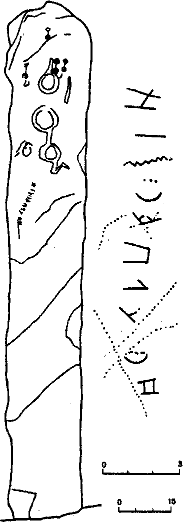Türkic Scripts - Codex of Inscriptions
Euro Asiatic Subgroup
S. Enisei (Orkhon) Script
|
Introduction |
|
I.L.Kyzlasov in his book Writings Of Eurasian Steppes assembled a Codex of Inscriptions. The Euro Asiatic group, per I.L Kyzlasov, includes Don, Kuban, S. Enisei, Achiktash, and Isfar scripts. I.L Kyzlasov attributes the S. Yenisei script to the population of the Kök-Türkic Kaganate, and more specifically to the Dögü (Eastern) Kök-Türkic Kaganate (552-840 AD) in the period of 8-th - 10-th c. |
|
Links |
|
Orkhon inscriptions boast a huge collection of studies and
publications. For details about the most famous inscriptions click below.
Ilterish Inscription (690-692 AD)
|
|
Codex of Inscriptions - S. Enisei |
SE 1. Sulek 3 ("Kara-Üs, stk. 2")
Graffiti on a rock. A horizontal line of 10 signs. Total length 12 sm, height of signs 2-2,5 and 1,3-1,5 sm.
Date undetermined.
Found by I.R.Aspelin in 1887 among images of Sulek inscriptions on the left bank of r. Pechishche, a left inflow of r. Black Iüs (Khakassk. - Khara Ÿÿs) (Fig. 3,7).
Located in the place of finding.
SE 1. Sketch by the author
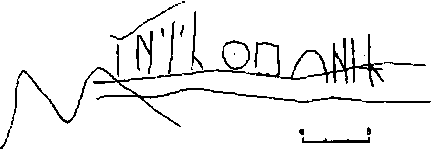
.Publications:
Totterman A. Entzifferungsversuch einiger Inschriften auf einer Felsenwand bei Suljek (Ostsibirien.) Helsingfors, 1888
Totterman A. Inscriptions de rie'niasei '. Helsingfors, 1889, N5 XXXII;
Appelgren-Kivalo H. Alt-altaische Kunstdenkmaler. Helsingfora, 1931, Abb. 77, 89;
Kyzlasov I.L. Ancient Türkic runic writing of Eurasia, Fig. 22, 23,7.
Attempts to read:
Totterman A. Entzifferungsversuch einiger Inachriften auf eine/Felaenwand bei Suljek
Totterman A. . Entzifferungsversuch einiger Inschriften auf einer Felswand 1m Kreise Minusinsk. - tifvenigt af Flneka Vetenskaps Societetens Forhandlingar. Helsingfors, 1888, Bd. 31
Totterman A. . Studien Ober die Suljekfelaen-Inschriften. Helsingfors, 1889
Totterman A. . Fiinf Suljekinschriften nach ihren Texten festgesteilt. Helsingfors, 1891
Donner O. Die Felseninschrift bei Suljek. - Ofvenigt... Bd. 31
Radloff W. Die altturkiachen Inachriften der Mongolet. Lfg. 3. St-Pbg., 1895, c. 345
Orkun H.N. Eski turk yazitlan. 3. Istanbul, 1940, c. 193-195 (facsimile: Ankara, 1987, c. 603-605);
Malov S.E. Yenisei writing of Türks. M. - L., 1952, p. 68, 69;
Vasiliev D.D. Corpus of Türkic runic monuments of Yenisei basin. L., 1983, p. 28, 29.
Transcription
Not available
Transliteration
Not available
Translation
Not available
SE 2. Sulek 4 ("Kara-Üs, stk. 3")
Graffiti on a rock. A horizontal line of five letters, length 4,7 sm. Height of signs 1,5-1,7 and 2,9 sm.
Date undetermined.
Found by I.R.Aspelin in 1887 on the same inscription.
Located in the place of finding.
SE 2. Sketch by the author

Publications:
Totterman A. Inscriptions de rie'niasei '. Helsingfors, 1889, Nî XXXII;
Appelgren-Kivalo H. Alt-altafcche Kunstdenkmaler, Abb. 77
Kyzlasov I.L. Ancient Türkic runic writing of Eurasia, Fig. 22, 23, 2.1
Attempts to read:
Vasiliev D.D. Corpus of Türkic runic monuments of Yenisei basin. L., 1983 p. 29.
SE 3. Sulek 5 ("Kara-Üs, stk. 4")
Graffiti on a rock. A line of 11 signs, length 20,5 sm. Height of letters from 2 to 4 sm.
Damaged by modern vandalism.
Date undetermined.
Found by I.R.Aspelin in 1887 on the same inscription.
Located in the place of finding.
SE 3. Sketch by the author

Publications and attempts to read:
See bibliography to SE 1, and also:
Appelgren-Kivalo H. Alt-altaiche Kunstdenkmaler, Abb. 88;
Kyzlasov I.L. Ancient Türkic runic writing of Eurasia, Fig. 22, 23.2
SE 4. Sulek 6 ("Kara-Üs, stk. 6")
Graffiti on a rock. A horizontal line originally of 25-26 signs. Presently survived four first, in part a fifth, the sixth and, after a significant lacuna, last nine characters. Total length of the text 51 sm, height of signs in the beginning of a line from 4 to 5,8 sm, in the end - from 1 to 3,5 sm.
Date undetermined.
Found by I.R.Aspelin in 1887 on the same inscription.
Located in the place of finding.
Fig. 39. Location of runic inscriptions on surfaces of the
Sulek inscription.
Sketch by the author from a reproduction by Kh. Appelgren-Kivalo
(Numbers correspond to the order of the description and
index of inscriptions)
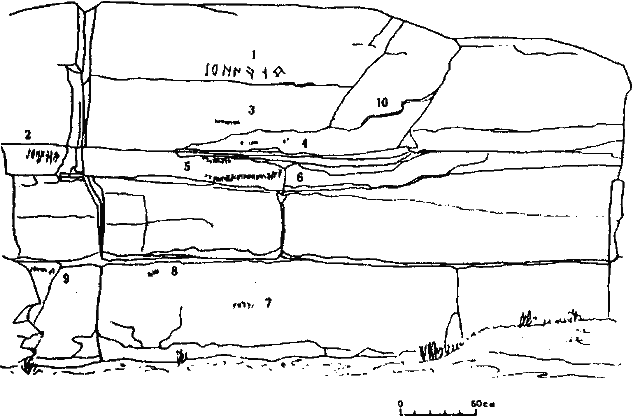
SE 4. Sketch by the author
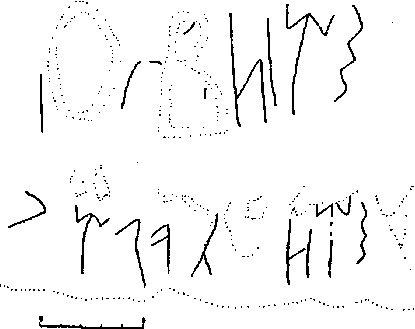
Fig. 40. Sulek inscription
Tracing of line 7 (signs 69-73 of the edition of 1889)
By Kh. Appelgren-Kivalo
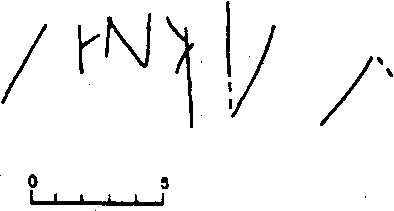
Fig. 41. Sulek inscription. Arrangement of inscriptions
Sulek 3-6 (SE 1 - SE 4).
Sketch by the author
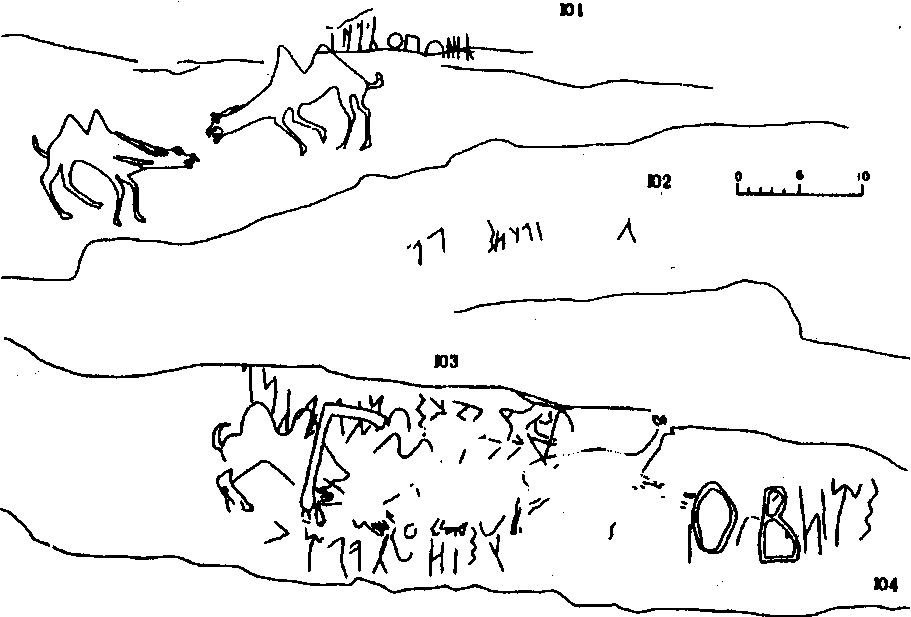
Fig. 42. Inscription Sulek 3 (SE 1) by X. Alpelgren-Kivalo
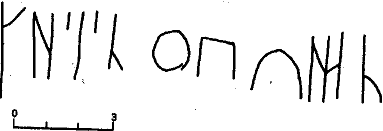
Publications and Attempts to read:
See bibliography to SE 1 and SE 3, and also:
Kyzlasov I.L. Ancient Türkic runic writing of Eurasia, Fig. 22, 23.3, 25.2
The first atlas of the runic inscriptions surveyed by the expedition of I.R.Aspelin in 1887-1888, "Inscriptions de 1'Ienissei", opened with a table showing drawings and writings of the main surface of the Sulek inscription. Seven its inscriptions (73 signs) were also shown separately with a schematic sketch. Archeologists noted that letters were put later than the drawings. The inscriptions of the Written Mountain became one of the first to vex the scientists with its reading. Even before the decoding of the Türkic runic signs was unsuccessful attempts to read the Sulek inscriptions. Then A.Tëtterman published I.R.Aspelin's sketches, distinct in details from those published later by Kh Appelgren-Kivalo (Tab. XL, XLI).
V.V.Radlov in 1895 suggested an attempt to read, at the same time noting: "These inscriptions are so vague that their decoding is almost impossible. The following Texts are very rude attempts of decoding". The scientist expressed also an opinion about the mutual relation of figures and inscriptions: "I do not believe that the inscriptions are chiseled over the drawings, I think that drawings were made later". Publishing the inscriptions in a runic typographical set, V.V.Radlov also considerably deviated in understanding of separate signs from the Sketches of the Finnish expedition (Tab. XL, XLI). He disregarded trhe 3rd and 7th inscriptions (Fig. 39) where the members of the Finnish expedition were not sure in characters. In the 1931 Kh. Appelgren-Kivalo, publishing I.R.Aspelin's materials, published not only the general image of the inscription showing all of its details, but also good Sketches of the originals of a nuimber of the Sulek inscriptions. In 1940 H.N.Orkun, without knowing about that publication, republished a general view of the inscription and by the Radlov's interpretation of the signs gave a somewhat different reading of the inscriptions. He dropped the unclear seventh line. In 1948, reproducing again the Finnish drawing of the boulder, L.A.Evtühova brought her obsrvations of the composition and relative chronology of images and inscriptions. This topic was reviewed also by S.V.Kiselev. For S.E.Malov. the reading of the Sulek inscriptions, taken, contrary to the drawings of the first finders, as parts of the single text (a Türkologist scientist called it "epitaph on a rock"), caused significant difficulties. The researcher noted a few times unusual combinations of letters. In accordance with the numbers in the S.E.Malov's summary work, the Sulek inscriptions are designated with index B39. Traditionally, as a six-liner, the inscription is shown also in the Sketch in the last by the time of its edition publication of the monument by D.D.Vasiliev, though he stipulated that the inscription, probably, does not present a single text. Reproducing the third line per the Finnish atlas, he, without comments, does not include the signs 69-73 of the publications of the 1889. Offering a transliteration of inscriptions, D.D.Vasiliev corrects a discrepancy in the reproduction of the "line 4" by S.E.Malov.
The study of the monument original in 1985 confirmed the impression arising from the works of researchers who saw the inscriptions themselves. The inscriptions are scattered all over the surface of the rock. They, undoubtedly, are separate and cannot be a single text (Fig. 39). The inscriptions published by the Türkologists as the first and the fifth lines of the monument are made with the Yenisei script (E 39/1-2: Sulek 1 and 2 - Fig. 18; 39,1,2).
In the atlas of 1889 one more line of inscription, the researchers were not sure of the letters' shape (signs 69-73). Judging by the general view of inscription presented there, these signs are located between the two bottom figures of running deer in the first tier of the image (Fig. 39,7). A large image of them published Kh. Appelgren-Kivalo, Fig. 87 (Fig. 40). Probably, taking into account the doubts of the archeologists, in their readings of the Sulek inscriptions, the Türkologists ignored these signs. In 1985 there was no more opportunity to check these tracings, as the bottom side of the rock turned out to be painted over with oil paint. A number of rune-like inscriptions given on the general view of a rock were not published as inscriptions by the Finnish researchers. We surveyed all of them: the lines at the bottom left horseman are nowadays covered by paint (Fig. 39,8); the etchings at the left bottom edge of the surface (Fig. 39,9), probably, are parts not completely distinguishable images; the surface of a rock to the right of the galloping "from the mountain" upper horseman (Fig. 39,10) no artificial markings at all. Are not the inscriptions also the three groups of tracings, rune-like shown on the copy of the inscriptions by V.F.Kapelko, shown in the Khakass republican museum in Abakan (below line E 39/2 are not runs, but thinly drawn inscription "year 1947"; in the middle tier at the left, under an Ô-shaped figure are parts of drawings (a paw of a leopard and horses); in the bottom tier above the image of an Greek orthodox cross are lines which are not runes.
Sulek inscriptions SE 1-SE 4 received a paleographic evaluation in 1988 and were published as samples of newly found alphabet in 1990.
The top inscription SE 1 is located above the figures of two assailing camels (Fig. 41). The inscription and image of the right camel do not overlap, however the last sign of the text and the back hump of an animal practically touch. The location of the drawing of the camels allows to believe that the letters appeared later and were marked in the free field toward the image, i.e. from right to left. In the editions of Türkologists the inscription is shown as the second line of the "Sulek text" (Fig. 39,5). Our understanding of signs (Tab. XL) a little differs from the one published in the 1889 atlas. Note that the field sketch of 1887 published by Kh. Appelgren-Kivalo, (Fig. 42) does not agree with the drawings in the atlas. It is necessary to also keep in mind the the 1889 atlas table of forms of the runic signs. At the same time precisely based on the features of this field record (shown in 1889 only in the general view of the inscription) were the readings the inscription by V.V.Radlov. As a result, the signs 3-5, 7 and 9 were interpreted as approaching the signs of the Yenisei script, and were rendered with a type-setting typeface. In this form they were reproduced in the H.N.Orkun's works (who read them differently), S.E.Malov (who gave a third alternate of the reading ) and D.D.Vasiliev (different transcription of the fifth sign) (Tab. XL).
Table XL Perception of signs of inscription Sulek 3 (SE 1) by various researchers
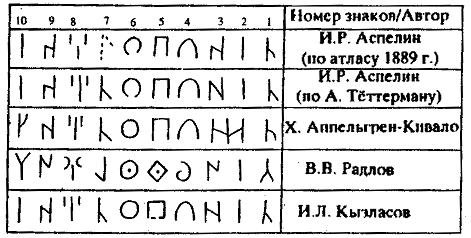
Inscription SE 2 is below and to the right from the described inscription (Fig. 39,4, 41). The surface of the stone in this place is disturbed by slight scorching, and there is no complete confidence that the lines are letters. Signs are on free from the figures section of the rock, though 3,5 and 6,5 sm to the left and to the right are angular marks which in our opinion are not letters. In the atlas of 1889 are reflected the researchers' doubts in the perception of the alphabetic signs. Probably, for that reason they were not used in the reading by V.V.Radlov, H.N.Orkun and S.E.Malov ("line 3" is marked by dots). D.D.Vasiliev, guided by the atlas, offers a transliteration of four signs (including one on the right aside from the others) as letters of the Yenisei writing, though in his sketches this inscription is absent.
.Inscription SE 3 is separated from the described inscriptions by a significant horizontal splinter. It is placed above a drawing of another pair of fighting camels (Fig. 39,5, 41). The text and the image overlap. This was noticed by L.A.Evtühova and S.V.Kiselyov who thought the camel pictographs were later. Nowadays the inscription and images suffered from barbarously chiseled autographs, and not all details are equally distinct.
Fig. 43. Inscriptions Sulek 5 and 6 (SE 3, SE 4) by Kh. Appelgren-Kivalo
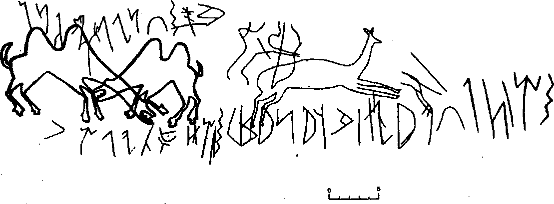
We believe, however, that the most indicative for the study of the relative chronology is the location of the three last signs of the inscription. They obviously follow the back and hump of the camel. It feels that the previous letters overlap the image of the left camel, the writer did not change the direction of the line. Thus, we come to an opposite from our predecessors conclusion: the inscription was made on the rock after the camels. It evidences that the inscription was written from right to left. Like the authors of the 1889 atlas (Fig. 43), we distinguish in this inscription 11 runic signs. Material differences arise only in inferring of the sixth sign. But the understanding of the signs differ. The members of the Finnish expedition, like all Türkologists studying inscription, linked these letters with the Yenisei letters. Besides, in the atlas, before the first letter of the inscription somehow appeared one more sign (sign 25), absent in the sketches made by the expedition. V.V.Radlov added on the right one more sign, a vertical line ("line 4"). After him, in such amended state, the inscription was taken by H.N.Orkun, and S.E.Malov, and D.D.Vasiliev. Probably, for these non-existent signs were confused the lines of the figure of the archer, representing one of the earliest petrographical periods of the writing, the Tashtyk epoch (1st century BC - 5 century AD; see Fig. 43).
The fourth S.Yenisey inscription (SE 4) of the Writing Mountain is most extensive and is below the third one, under the camels' image (Fig. 39, 41). Like the figures, it strongly suffered from the modern chiseling. Judging by the materials of the Finnish expedition (Fig. 43), the inscription consisted of one continuous horizontal line. The writer, probably, was placing text under the already existing images of the deer and camels. On the sketch of 1887, a part of letters covers the rear legs of the deer. The inscription was read by the Türkologists as Yenisean ("line 6"). Doing it, V.V.Radlov departed from the forms of signs in the atlas not only in adjusting them to the known alphabet, but also partially changing them. Only in some number of such amendments he followed the field sketches of the 1887 expedition (Tab. XLI, ¹ 1, compare sign 44 of the 1889 atlas). The Radlov's understanding of signs was accepted by H.N.Orkun and S.E.Malov, who offered slightly different transcriptions of the text. If the interpretation of letters by V.V.Radlov was published with means of type-setting runes, D.D.Vasiliev published the sketch that was actually a hand-written rendition of the typographical set. Only some signs were returned to the tracings found by the Finnish expedition (Tab. XLI). From this basis was received the transliteration of the inscription different from the predecessors' transliteration . Nowadays the spoiled inscription does not look any more as a continuous line of text. Clearly visible are the first four letters, the fifth and the sixth can be restored by the surviving parts. The subsequent runes under the figure of the deer did not survive. The sign 17 raises doubts (Tab. XLI), indiscernible is the top corner of the 18th letter. The 19th and 20th signs are confidently visible, four last runes survived completely. This text, rendered later than the images located above it, in a number of places, undoubtedly, included earlier lines not related to the inscription. These are the etchings under a rear leg of the right camel, right from the signs 23-26. If the presence here of the 22nd letter is still probable, the lines shown in a number of sketches as signs 21, are undoubtedly not connected to the text. The writer, probably, skipped here the previously damaged surface. It is impossible to take absolutely confidently the letter and the tracings in front of sign 17. In 1985 it was not possible any more to review the relative chronology of the inscription and the image of the deer. S.V.Kiselyov believed that the figure of the animal was drawn on the rock later than the text.
Table XLI Reading of signs of the Sulek 6 (SE 4) inscription by different researchers
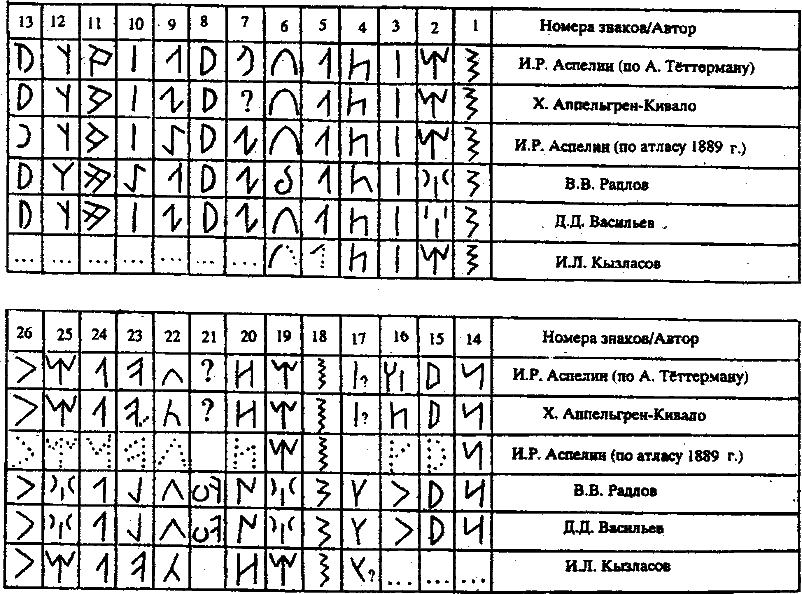
SE 5/1-2. Spindle weight of the Minusinsk museum
Graffiti on narrow (SE 5/1) and, probably, on the wide side (SE 5/2)
jasper spindle weight. The inscription 1 consists of 25 signs along the whole length of
the rim side. Length of the line 11 sm, height of signs
from 0,4 (in the beginning of the text) to 1 sm (in the end). The
inscription 2 is separated conditionally by three rune-like tracings.
Date undetermined.
Accidental find in Khakass-Minusinsk depression, of not later than 1896.
Stored in Minusinsk museum, cat. ¹ 9530.
SE 5. Sketch by the author. SE 5/2 - without scale

Publications:
Kiselyov S.V. Writings of Yenisei Kyrgyzes. - KSIIMK 1949, issue 25, Fig. 9,6, 10;
Kiselyov S.V. Ancient history of Southern Siberia. - MIL 1949, 9, Tab. LIII, 15;
Rygdylon E.R. Ancient Türkic runes of Baikal. - EV. 1953, 8, Fig. 3, 4;
Vasiliev D.D. Ancient Türkic epigraphs of Southern Siberia. - TC 1975. M., 1978, photo 4, 5, Fig. 2;
Vasiliev D.D. Corpus of Türkic runic monuments of Yenisei basin. L., 1983, p. 74, 116;
Kyzlasov I.L. Ancient Türkic runic writings of Eurasia, Fig. 26,1, 1A.
Attempts to read:
Kiselyov S.V. Writings of Yenisei Kyrgyzes. - KSIIMK 1949, issue 25, Fig. 9,6, 10;
Kiselyov S.V. Ancient history of Southern Siberia. - MIL 1949, p. 346, 347;
Kiselyov S.V. Ancient history. 1951, p. 613.
The first information about this monument dates to 1896. Then in the department of chronicles in the 4th volume of "Archeological news and notes of the Moscow archeological society" appeared the following brief message: "The custodian of the Minusinsk museum, N.M.Martyanov, after 23-years stay in Siberia, this summer visited museums of the European Russia and Caucasus, and was at the Riga Congress (X Archeological Congress, August 1-15, 1896 - I.K.) where, informing in private conversations about many new and interesting information about the Siberian archeology, showed a recently found spindle weight with a runic inscription (and, maybe, also with Chinese signs). It is the first known sample of an everyday subject with Siberian runes. Nowadays Acad. Radlov studies this spindle weight". V.V.Radlov's observations were not published and remained unknown. For a long time the find, stored in the funds of the Minusinsk museum under ¹ 2164 (nowadays - ¹ 9530), did not attract attention.
Spindle weight was again found there in 1940 by the first professional archeologist of the museum, V.P.Levashyova. She gave a drawing and a plasticine imprint of the inscription to S.V.Kiselyov, who in 1949 published a sketch of the text and a photo of the mold. S.V.Kiselyov, developing a transliteration of the inscription, noted, that " its letters are rather original and differ considerably from others from Yenisei". The scientist offered phonetic correlation to a number of original signs, noted their relationship with the graphics of the Talas plank, and of the letter "ladder" with the "Besenyo" script and Hungarian engravings. In the same year S.V.Kiselyov published in the book a photo of a print. S.E.Malov during a visit in the summer of 1948 to the Minusinsk museum saw the spindle weight. E.R.Rygdylon also handed to the researcher prints of the inscription, however the results of the outstanding Türkologist's work with this monument were not published. S.E.Malov only expressed once a hope that gradually the inscription will be deciphered. In 1951 E.R. Rygdylon, considering the S.V.Kiselyov's publication, limited himself to a brief mention of the spindle weight and a remark about unlikeness of some signs on the inscription with the Yenisei alphabet. In 1953 the researcher published a photo of a print of the inscription (probably, a similar print was also handed to S.E.Malov) and its sketch, accompanied with their brief description and a comparative paleographic table. In 1961 A.M.Scherbak, visiting Minusinsk museum, unfortunately, could not find the spindle weight in its funds. The reason, probably, was an absence at that time a professional archeolog, with a good knowledge of the collection, on the staff of the museum. In his 1970 work A.M. Scherbak noted the publications of his predecessors and fairly noted that the signs on the spindle weight "obviously expressed a Yenisei character". In the middle of the 60ies an archeologist N.V.Leontiev started to work again in the Minusinsk museum, and the spindle weight with the inscription became again accessible to the researchers.
In 1978. D.D.Vasiliev, having studied the original, published a new sketch of the inscription, photo pictures of the toned signs on the lateral surface and the traced photos of the surfaces of the planes spindle weight, noting there rune-like marks. In 1983 these materials, completed with the photo of the traced general view photo of the spindle weight, drawings of its surfaces and one picture of the toned inscription, a brief description of the subject and incomplete bibliography, were republished. Despite of the differences of the signs of the runic text from the letters of the Yenisei inscriptions, also noted by D.D.Vasiliev, this written monument only by its place of find received an index E 87, which conflicted with the paleographic principle of similar designations. In another work in 1983, the researcher noted a similarity of the spindle weight signs with the letters of the east European inscriptions. We shall note that D.D.Vasiliev's sketch does not completely agrees with his photo of the toned signs on the inscription (compare: Tab. XLII, ¹ 1, 7, 11à, 12, 13, 21). Besides, the shape of the signs in these photos is different in details also from the editions of 1978 and 1983. The sketches of the inscriptions in publications also differ in the dimensions and, that is more important, forms of some signs (Tab. XLII, ¹ 9, 12-13, 17, 18, 20-22).
An acquaintance with the original convinces that the fullest and objective information about the inscription on the narrow side of the spindle weight are represented by the mold by V.P.Levashyova published in the works by S.V.Kiselyov. On some published sketches were transferred some later damages to the surface of the text ( Tab. XLII, ¹ la, 12a, 17à, 25à and á). The tracings of 18à are accidental and appeared, probably, before the creation of the inscription. The point 13à is wider and smaller than the similar signs, therefore there is no confidence that it belongs to the text. Thin crossbeam scratches of signs 18 and 22 touching neighboring letters that are not present in other runes cause doubts. The inscription is scratched with wide and deep strokes, it looks like it is cut with a knife. One of the wide sides of the spindle weight is does not have writtengs, on the second are three isolated rune-like figures (SE 5/2). There is no confidence that they are letters. Other lines, noted on this side of a subject by D.D.Vasiliev, definitely are not alphabetical signs. The inscriptions of the spindle weight were studied paleographically in 1988 and were published in our summary work in 1990.
Table XLII
Perception of signs on spindle weight in Minusinsk museum (SE 5/1) by different researchers
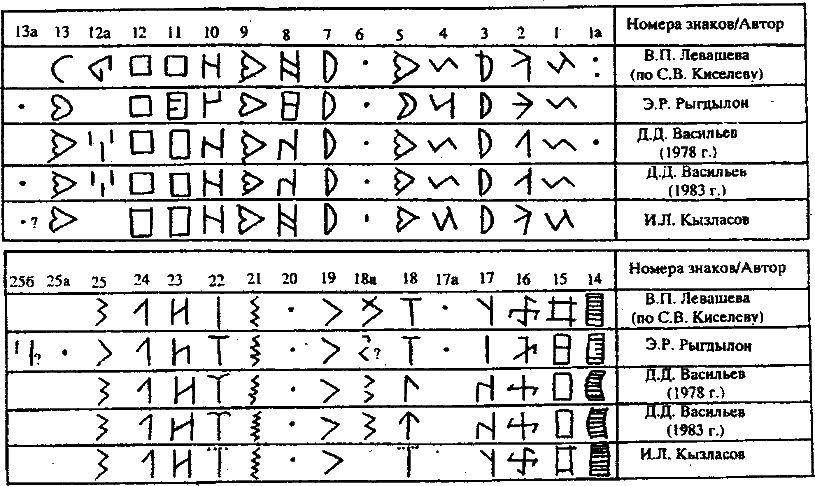
SE 6. Uybat
Graffiti on a bottom of a silver vessel. A line of four signs, length 0,7 sm. Height of the letters 0,35-0,4 sm.
Date - end of 8th - first half of 9th century.
Found in 1928. by S.A.Teplouhov at excavation of a tomb 19 on Uybat chaatas (r. Beyka, the right inflow of r. Uybat, left inflow of r. Abakan) (Fig. 3,2).
Stored in State Hermitage, cat. ¹ 4899/2.
SY 6. 1 - by A.N.Bernshtam, 2-3 - sketch by the author, 2 - general view
of the slashes on the bottom,
3 - initial slashes on bottom
![]()
Publications:
Bernshtam A.N. Ancient Türkic script at river Lena. - EV. 1951, 4, Tab. 11,7;
Kyzlasov I.L. Ancient Türkic runic writings of Eurasia, Fig. 26,3, 4, 4A.
Attempts to read:
Bernshtam A.N. Social and economic system of Orkhon-Yenisean Türks in 6th - 8th centuries. M. - L., 1946, p. 69;
Bernshtam A.N. Ancient Türkic script at river Lena, p. 85.
The vessel was originally stored in the State museum of ethnography of USSR
peoples (Leningrad), and then, by L.R.Kyzlasov's initiative, the S.A.Teplouhov's
archeological collections were transferred to
the State Hermitage. The inscription on its bottom, made with deep slashes, but
damaged by thr work of restorers, was found by A.N.Bernshtam, who
published the first version of its reading in 1946. In 1951 the researcher published
a sketch of the runic text and its new reading, also done
on the basis of the Yenisei alphabet. A.N.Bernshtam believed that in two lines
of this inscription a same phrase was repeated twice. In 1983. D.D.Vasiliev,
republishing the A.N.Bernshtam's sketch and giving the obsolete information of
its storage place and incorrect date of its find, noted that phonetically "some signs cannot be identified
with certainty". Meanwhile
the acquaintance with the original reveals obvious conflicts in A.N.Bernshtam's publication.
First, the second line of the text is
completely absent and, probably, "arose" due to overlapping of two sketches
of the same signs by A.N.Bernshtam. Secondly, as letters can be taken
only first three signs of his reproduction. On the bottom of the
vessel in addition to the three letters and a stroke cut together
with them, are some tracings overlapping each other. The top "layer" has
tamga-like signs, the lowermost
has twisting and cross figures. The
inscription belongs to pre-tamga
writings and either is simultaneous with the
lowermost "layer", or prior to it. Among the top lines understood by A.N.Bernshtam as a continuation of the inscription, the slanting cross is
different in depth from the letters, and the following scratches are
even thinner, and probably, unintentional damages of the surface. The initial cross
belongs to the late layer of the
tamga-like signs. The said allows us to count
only four deep signs, though their smallest sizes create certain doubts.
The form of the first letter convinces that the inscription is done with S.Yenisey script and incorrectly received in the literature
the index of the Yenisei texts - E 83.
SE 7. Sargol
Graffiti on a fragment of a rock. One slanting line of 17 signs. Overall length about 14 sm, height of letters from 1,2 to 1,7-2 sm.
Date unclear.
Found in 1982 by M.A. Devlet in the gorge connecting valleys Ortaa-Sargol and Mugur-Sargol on the left bank of the r. Yenisei (Fig. 3,3).
Located in the place of find.
SE 7. By M.A.Devlet's sketch
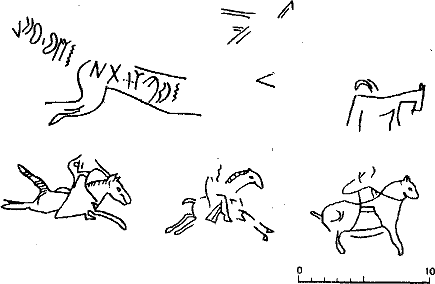
Publications:
Devlet M.A. Petroglyphs of the nomadic path. Ì., 1982, Tab. 28,7.
Attempts to read:
None published.
Below the inscription in a like manner are grooved figures of three horsemen, to the right of the text is grooved an animal. The right part of the inscription is on the image of another animal, probably a deer. Apparently, the runes were chiseled on the rock after the images, the break in the line of the text shows that the writer avoided the lines of the image. The thirteenth sign (a short stroke), probably, is word separator. Paleographic study of the inscription was in 1988, sketch was reprinted in 1990.
SE 8. Aimyrlyg I
Graffiti on a horn layer of a combat bow. A line of nine letters, length 7,2 sm. Height of letters from 0,9 to 1,4 sm (once - 1,7 sm).
Date - 9-10 century.
Found by A.M. Mandelshtam and B.B.Ovchinnikova in 1971 at excavation of a kurgan 52 in the group 8 of the Ajmyrlyg 1 burial grounds on the left bank of the r. Chaa-Hol, the left inflow of r. Yenisei (Fig. 3,4).
Located in IIMK of the Russian Academy of Sciences (?).
SE 8. By B.B.Ovchinnikova's sketch

Publications:
Vasiliev D.D. Corpus of Türkic runic monuments of Yenisei basin. L., 1983, p. 81;
Kyzlasov I.L. Ancient Türkic runic writing of Eurasia, Fig. 28,2
Attempts to read:
Vasiliev D.D. Corpus of Türkic runic monuments of Yenisei basin. L., 1983, p. 46.
SE 9. Ajmyrlyg II
Graffiti on a horn layer of a combat bow. A line with traces of two letters and one whole letter. Length of line 2,2 sm, height of script 1,3 sm.
Date - 9th-10th century.
Found by A.M.Mandelshtam and B.B.Ovchinnikova in 1971 in the same kurgan as SE 8.
Located in IIMK of the Russian Academy of Science (?).
SE 9. By B.B.Ovchinnikova's sketch

Publications:
Vasiliev D.D. Corpus of Türkic runic monuments of Yenisei basin. L., 1983, p. 81;
Kyzlasov I.L. Ancient Türkic runic writing of Eurasia, Fig. 28,2.
Attempts to read:
None published.
The sketches of the horn laminators with signs by B.B.Ovchinnikova were published by D.D.Vasiliev, who suggested a partial transliteration of the long inscription on the basis of the Yenisei alphabet. The monuments unjustifiably received an index of the Yenisei texts (E 141 and E 142). The shape of the third sign of the SE 8 can be vcariously interpreted (as ¹ 29 or as ¹ 4 on Tab. XV). A paleographic study of the inscriptions was done in 1988, sketches of them were republished in 1990.
SE 10. Lake 2
Graffiti on a rock. A vertical line of 17 signs, length 18,6 sm. Height of signs from 0,9 to 2,2 sm, on the average - 1,5 sm.
Date undetermined.
Found by V.F.Kapelko in 1977 on the Lake Mountain, on the left bank of the r. Pechishche above lake Sulphatic (Buzun) (Fig. 3,7).
Located in the place of find.
SE 10 Sketches by the author
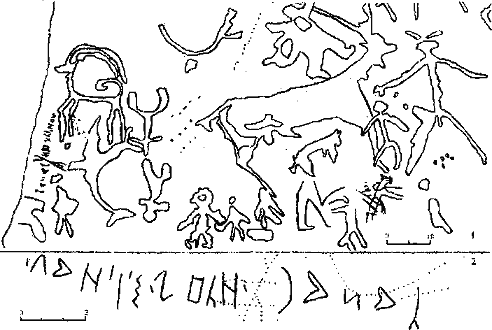
Publications:
Kyzlasov I.L. New runic writings of Southern Siberia. - Archeology of Mountain Altai. Gorno-Altaisk, 1988, Fig. 1;
Kyzlasov I.L. Ancient Türkic runic writing of Eurasia, Fig. 29.
Attempts to read:
None published.
In 1977 in Khakassia during survey of the Lake Mountain by V.F.Kapelko and E.A.Sevastjanova was found an inscription on the fifth mountaintop from the Sulek inscription (Fig. 3,7). Due to the information provided by the researchers, the author managed to get acquainted with the original. Anthropomorphic and zoomorphic figures are chiseled on the rock outcrop with the inscription. Deeply cut letters are to the left of the figures by the edge of the rock. A blank space in line is explained by intentional skipping of the damaged spot on the rock. The inscription contains 11 types of the S.Enisey letters and ends with a short stroke. A rune ¹ 32, not found anywhere else, links it with the S.Enisey incriptions of the Written Mountain (SE 1-SE 4) (Tab. XV). The inscription was published in 1988, with V.F.Kapelko's sketch, and in 1990 with the sketch by this author. This is a second written monument from the Lake mountain, the first inscription is written with Yeniseian script (E 138, Fig. 22).
SE 11. Turan 3
Graffiti on the menhir of an early Iron Age kurgan. A vertical line of 19 signs, length 21 sm. Height of letters 1,5-2 sm. A tamga is engraved 20,3 sm above the text.
Date undetermined. (Central Asian "early Iron Age" is dated by early 1st millennium ÂÑ - Tanslator's Note)
Found by in 1977 by V.F.Kapelko in a vale on the Turan mountain on the left bank of the r. Yenisei (Fig. 3,5).
Located in place of find.
SE 11. Sketches by the author
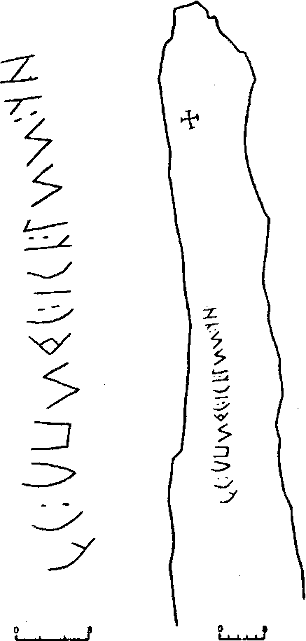
Publications:
Kyzlasov I.L. New runic writings of Southern Siberia. - Archeology of Mountain Altai. Gorno-Altaisk, 1988, Fig. 1;
Kyzlasov I.L. Ancient Türkic runic writing of Eurasia, Fig. 32.
Attempts to read:
None published.
Due to the information received from V.F.Kapelko and with B.N.Pyatkin's assistance, in 1981 we surveyed the written monument site together with L.R.Kyzlasov. The inscription is south-east side of a corner slab of the kurgan fencing, its height 1,4 m, and width 1 m. The height of the narrow side 1,16 m, width at the base 14 sm, at the inscription - 9 sm. The description, a sketch, and paleographic study of the inscription were published in 1988 and 1990. Also was published a sketch of one more, barely discernable, rune-like inscription Turan 4, which once was chiseled on a slab of another kurgan of the same burial grounds. The sequential numbers of the inscriptions include the rock inscription texts Turan 1 and 2 (E 118).
SE 12. Edegey 2
Graffiti on a stele of a commemorative fencing. A vertical line of 11 signs, length 12,8 sm. Height of letters from 0,9 - 1,2 to 1,5 - 2 sm.
Date - after the middle of the 8th century.
Found by L.R.Kyzlasov in 1978 in Edegey burials (fence 17) at the foot of the Chinge-Dag mountains on the left bank of the r. Edegey - the left tributary of the r. Hemchik (Fig. 3,6).
Located in KhRKM, cat. ¹ 5677/8.
|
SE 12. Sketches by the author
|
|
Publications:
Kyzlasov I.L. New runic writings of Southern Siberia. - Archeology of Mountain Altai. Gorno-Altaisk, 1988, Fig. 2, 3,7;
Kyzlasov I.L. Ancient Türkic runic writing of Eurasia, Fig. 30,7, 2.
Attempts to read:
None published.
SE 13. Edegey 3
Graffiti on a stela of a commemorative fencing. The vertical line divided into three parts by a placed between the letters tamga and a space of 3 sm. Overall length 40 sm. In the three parts are seven, five and ten written signs accordingly, height from 1 to 1,7 sm.
Date - 9-10 century.
Found by L.R.Kyzlasov in 1978 in the same Edegey burial grounds (fence 17).
Located in KhRKM, cat. ¹ 5677/8.
SE 13. Sketches by the author
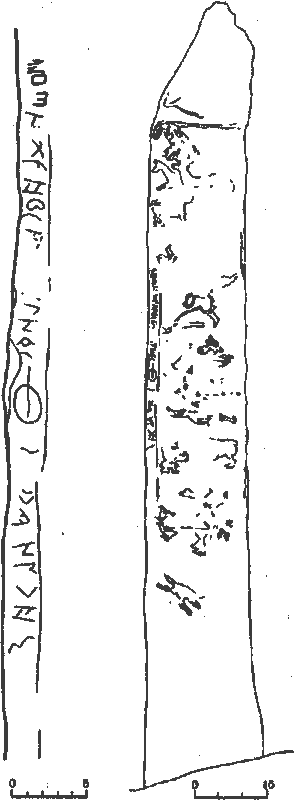
Publications:
Kyzlasov I.L. New runic writings of Southern Siberia. - Archeology of Mountain Altai. Gorno-Altaisk, 1988, Fig. 10;
Kyzlasov I.L. Ancient Türkic runic writing of Eurasia, Fig. 33,7, 2.
Attempts to read:
None published.
The Edegey burial grounds consist of eight kurgans of Uük culture (7-3 centuries BC), two stone kurgans, probably medieval, and seventeen commemorative, probably Uük structures partially re-used by the Tugü Türks. In two of them were found stelas with runic inscriptions. Text Edegey 1 is written with Yenisei alphabet with a use of two forms of the S.Yenisey letters (Fig. 5). The second inscription (SE 12) is on the eastern side of a slate stela (1,6 x 0,22 h 0,14 m) in a southern corner of a paired commemorative fence in front of which, in addition, "were installed Ancient Türkic sculptures and three lines of balbals. The vertical line of the text is a little slanted and consist of scored by thin grooves and in places barely legible signs. The vertical tri-dotting (sign 8), probably, serves as a word separator.
Inscription SE 13 is on the northeastern side of a narrow stela (1,7 x 0,22 x 0,2 m, top is broken off), which used to be in the center of the same commemorative fence. The whole side is covered with a multi-figured image of a chase hunt. The actions, scored by thin and shallow lines, are placed in several tiers. Vertically on the left side of the surface, one line of the runic inscription is separated from the figures by a specially drawn line. The inscription is unique in two aspects. First, among the runes is a tamga, identical to that of the Edegey 1 text (Fig. 5). Below the tamga are seven letters and a wavy line which can be interpreted in a few ways. Above, are two groups of runes: five following the heraldic sign and after an interval of 3 sm are another ten letters. This manner, resulted probably from the text written from left to right, is clearly visible in the top part of the inscription. The runes below tamga, in half of the cases have a usual turn. Exceptions are the last, the fourth and the fifth signs on the right. The description, a sketch and paleographic study of inscriptions SE 12 and SE 13 were published in 1988 and 1990. In 1987 we excavated the fence.
SE 14. Chinge
Graffiti on a rock. A horizontal line of 22 signs, length 24,5 sm. Height of signs from 1,5 to 4 sm, on the average - 2-2,8 sm.
Date undetermined.
Found by N.V.Leontiev in 1984 near the mouth of the r. Chinge, the right inflow of r. Yenisei (Fig. 3,7).
Located in the place of find.
SE 14. By N.V.Leontiev's sketch
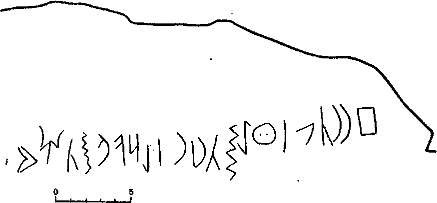
Publications:
Kyzlasov I.L. New runic writings of Southern Siberia. - Archeology of Mountain Altai. Gorno-Altaisk, 1988, Fig. 11;
Kyzlasov I.L. Ancient Türkic runic writing of Eurasia, Fig. 34,1.
Attempts to read:
None published.
On the left bank of the r. Chinge, near its mouth, cliffs overhang the waters of Yenisei. On the top tier, on a small facet of red sandstone (50 x 45 sm), located 5-6 meters from the stone ¹ 145 by M.A.Devlet numbering, are grooved with very thin lines illegible drawings. Above them, along the top edge of the rock, also with thin lines is grooved one horizontal line of a runic inscription. We published its description and N.V.Leontjev's sketch in 1988 and 1990, together with a paleographic study of the text.
SE 15. Edegey 4
Graffiti on a fragment of a stela. A vertical line consisting of 11 full and 4 partially preserved signs. Total length 15,8 sm, height of letters 2,5-3 sm.
Date undetermined.
Found by I.L.Kyzlasov in 1987 at excavation of the Edegey burial grounds fence 17 on the left bank of the of the same river.
Located in the Archeology Division of the Historical faculty of the Moscow State University.
SE 15. Sketches by the author
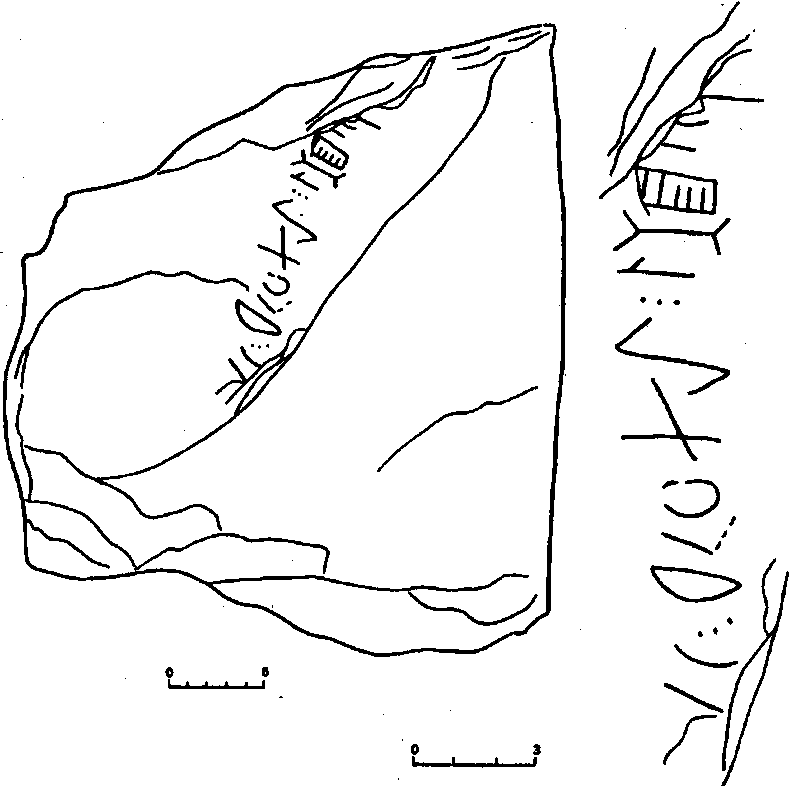
Publications:
Kyzlasov I.L. Ancient Türkic runic writing of Eurasia, Fig. 34,2.
Attempts to read:
None published.
SE 16. Edegey 5
Graffiti on two matching fragments of a stela. A vertical line in which are distinct 23 signs, height 1,5-2 sm. Overall length 30 sm.
Date-9th-10th century.
Found by I.L.Kyzlasov in 1987 at excavation of the Edegey burial grounds fence 17.
Located in the Archeology Division of the Historical faculty of the Moscow State University.
SE 16. Sketches by the author
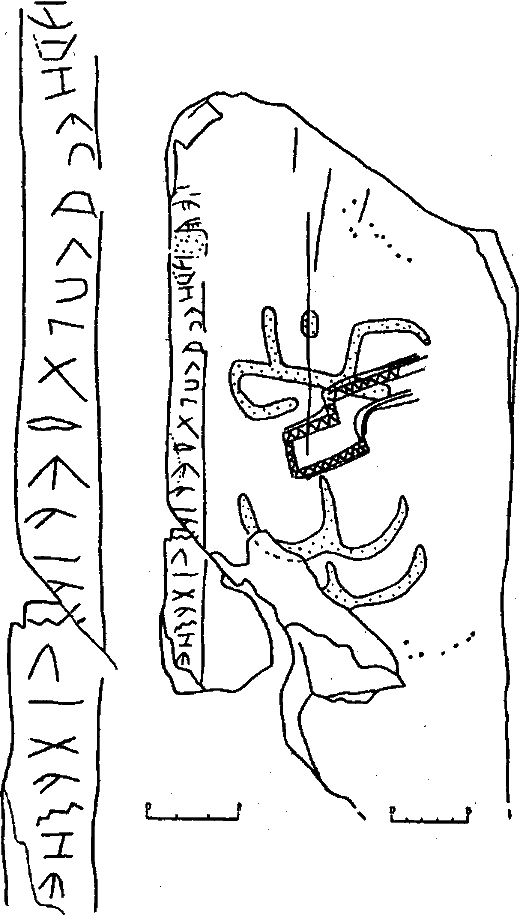
Publications:
Kyzlasov I.L. Ancient Türkic runic writing of Eurasia, Fig. 35.
Attempts to read:
None published.
SE 17. Edegey 6
Graffiti on a stela. A vertical line of three signs, length 3,3 sm. Height of letters 1,6 and 2 sm.
Date undetermined.
Found by I.L.Kyzlasov in 1987 at excavation of the Edegey burial grounds fence 18, adjacent with fence 17.
It was left in the location of the burial grounds at fence 18.
Þ17. Sketches by the author
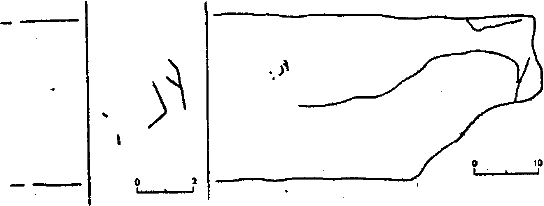
Publications:
Kyzlasov I.L. Ancient Türkic runic writing of Eurasia, Fig. 33,3.
Attempts to read:
None published.
In 1987 we dug out a double fence with monuments Edegey 2 and 3 (SE 12, SE 13). We found three new S.Yenisey inscriptions. The text Edegey 6 (SE 15) remained on a thin slate slab (28 x 29 x 2,4 sm), laying on the surface in the southern part of the object, probably a fragment of a narrow stela (with the face of 29 sm), where an inscription line was drawn lengthways, but at an angle to the long axis of the slab. The slab with inscription Edegey 5 (SE 16) was found near the previous inscription (SE 15), but under a layer of turf. Probably, it is too a knocked off part of the top of a stela (63 x 24 x 1,5-2 sm). Its width coincides with the size of the bases of two menhirs initially located at the southern corner of the object and in the center of its southern extension. In the middle of the fragment are chiseled tamga-looking signs and a carved composition, but all of them are made in a different manner and, hence, are asynchronous with the inscription along the edge of the stela, and intentionally separated from the other part of the surface by a groove line. Aparently, the text is written from left to right. For a number of signs is possible to discern that the left stroke was cut before the right, even if was a lateral stroke (runes 10, 13, 19, 20). We happened to find a small second splinter of this stela (12 x 8 sm), containing 8 signs. All letters of the inscription are done with shallow but wide (0,5 mm) grooves and, despite of the worn-out surface, exposed to the elements for a long time, they are distinguished quite clearly. Only four signs (1, 2, 4, 5) are problematic to recognize. The inscription SE 17 has three runic signs, grooved in one line at an angle to the long axis of the massive fragment of the stela (160 x 26 x 11 sm), which was laying along the eastern wall inside the northern fence, adjacent to the wall containing texts SE 12, SE 13, SE 15, SE 16. Apparently, the runes were engraved in a mirror image. Otherwise the first sign of the script should be recognized as a letter of the Yenisey alphabet, as in the S.Yenisey script this sign did not come up. The word separator finishing the inscription is a feature of the S.Yenisey script, unknown for the Yenisei texts. The sketches of the inscriptions SE 15-SE 17 were published in 1990.
SE 18. Karban
Graffiti on a wall of a small grotto. A vertical line of 17 signs. Overall length 20 sm. Height of letters 2,5-3 sm.
Date undetermined.
Found by V.N. Edin and E.P. Matochkin in 1988 near the mouth on the left bank of the rivulet Karban (left inflow of the r. Katun), accross from village Kuüs.
Located in the place of find.
SE 18.1 - By V.N. Edin's sketch, 2 - by E.P. Matochkin's sketch
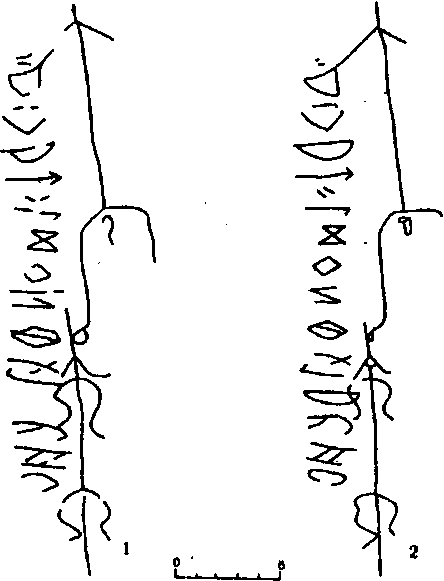
Publications:
Yelin V.N, Soyonov V.I. New archeological monuments in the zone of planned construction of Katun Hydroelectric Power Station. - Archeological research in Katun. Novosibirsk, 1990, Fig. 16,2;
Klyashtorny S.G., Matochkin E.P. Karban's Runic inscription. - ISOAN. History, philosophy and philology. 1991, ¹ 1, Fig. 1.
Attempts to read:
Klyashtorny S.G., Matochkin E.P. Karban's Runic inscription. - ISOAN. History, philosophy and philology. 1991, ¹ 1.
The inscription is adjacent to images, signs and lines, of not clear intentions and various chronology, it was published in two sketches executed by two researchers, V.N. Edin and E.P. Matochkin. The reproductions supplement each other in respect to the shape of some signs (compare, first of all, the runes 1, 4, 8, 16), although nevertheless it is possible to suggest that the shape of some letters (6, 7, 17) is not rendered completely accurately. Interpreting the inscription, S.G. Klyashtorny used only E.P.Matochkin's sketch which caused difficulties in understanding the letter 16. The inscription is apprized as Orkhon-Yenisean (so-called "Central Asian runic script"), containing two letters from the "Eastern European runes" set, he suggested a version of its reading (not a coherent text) and briefly stated a hypothesis about two stages of the existence of Ancient Türkic runic script, one more ancient, "undeveloped and primitive" in its usage, which engendered the "Eastern European alphabet" with local variations, and a later, "reformed" è "normative", characteristical for the Asian states. The use, in the Karban inscription, of non-Orkhon-Yenisean letters is viewed by the researcher as a relict usage of the pre-reform script. Meanwhile this inscription, undoubtedly, is written with the S.Yenisey alphabet. Out of its 14 different signs eight find a match in our Tab. XV, including rather specific letters: ¹ 5, 6, 18, 19, 21, 23, 25, 26. The ninth letter (third sign of the inscription) serves as a marker of the Yenisei inscriptions in Altai (Tab. XXIV, ¹ 40). There is also a letter as a rhomb (Tab. XXIV, ¹ 37 though there it, apparently, represents a variation of the rune á 2). This sign, and the tenth letter of the inscription, is among the Upper Yenisean signs in Tuva (Tab. XXVI, ¹ 3, 16; XXXI, ¹ 1, 4).
Thus, in the paleographic sense the investigated graffiti in fact can be apprized as an inscription of mixed graphics (only with a reservation that the complement of the known to us today S.Yenisey alphabet, certainly, is not complete). At the same time it is obvious, that this is not an Orkhon-Yenisean, but a S.Yeniseyan text showing the influence of the local tradition of writing in Altai and Upper Yenisean script.
E.P. Matochkin and the S.G. Klyashtorny are inclined to see next to the examined inscription a second line of text. However sketches offered by them and V.N.Yelin do not allow verification without a study of the original.
